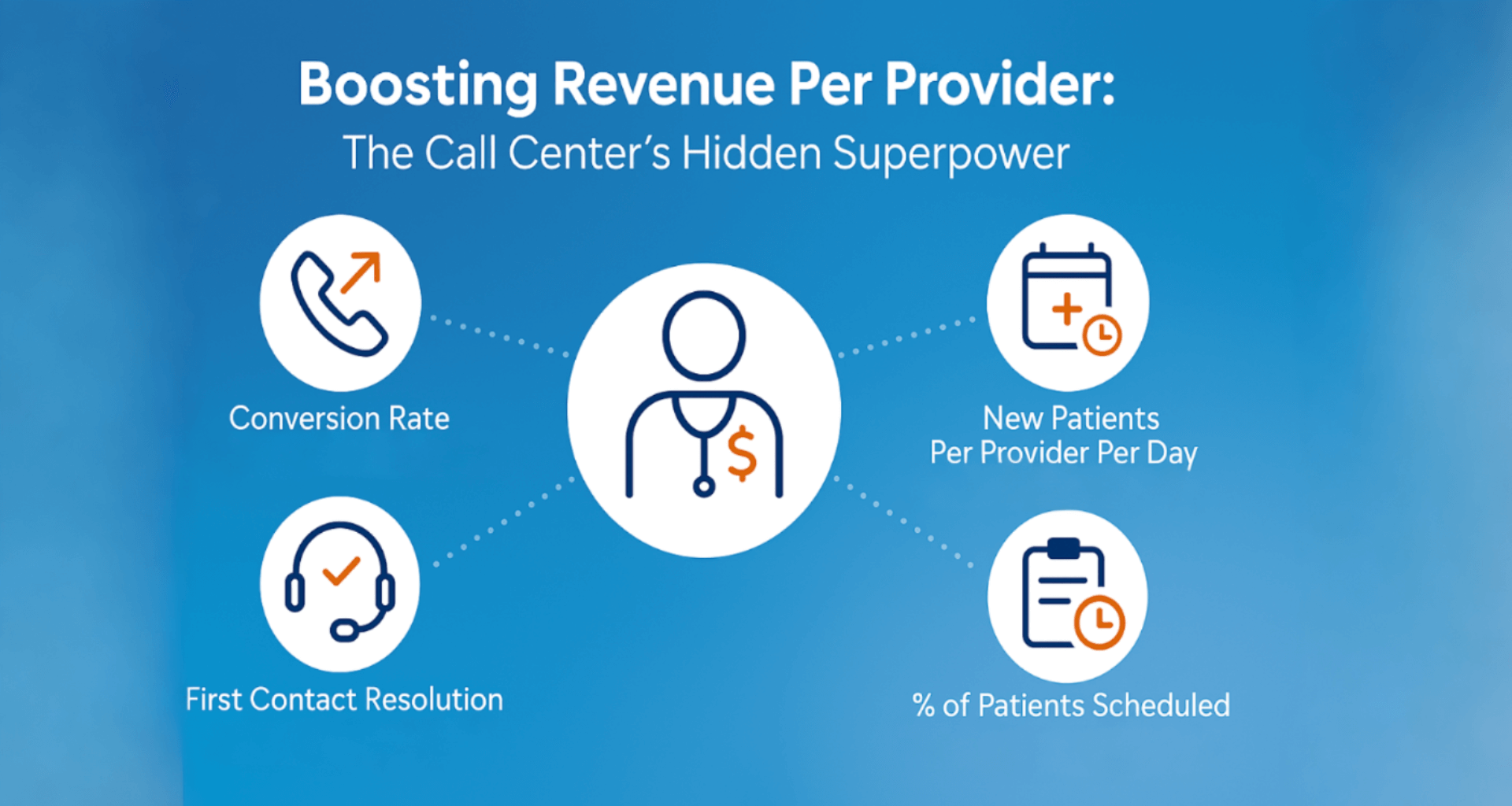
Medical call centers & other healthcare organizations are in dire staffing straights—& patients are paying the price
Given that you're reading this article, you're likely stuck in what we at Keona Health call the Staffing Trap: You lack the staffing resources needed to create positive patient access experiences. The Staffing Trap has been snagging healthcare providers, left and right, with astonishing efficiency. Call hold times and callback times are the longest they've ever been.
To blame for the healthcare staffing crisis, which has engulfed all corners of the industry, are a complex set of factors: Covid-19, The Great Resignation, a transforming economy, and more.
The staffing shortages are the biggest crisis facing the American healthcare system in decades. Half-empty medical call centers, operating at only two-thirds of their normal staffing levels—with the remaining few employees anxious, overworked, and miserable because they must manage a shocking number of patient calls—are a common sight.
The dire staffing situation at healthcare call centers translates to negative patient experiences. Patients find themselves waiting on hold, nervously pacing around their homes, desperate to speak with someone who can give them care or consultation, for countless minutes. Scheduling appointments is an even bigger nightmare: Patients must often wait until business hours to call, usually when they are at work, only to experience long hold times, phone tag, and scheduling errors. The difficulty of reaching their provider or care team, just to schedule an appointment, exhausts and aggravates patients, who are increasingly willing to switch to providers who offer online scheduling.
Customer satisfaction scores and staffing levels are plummeting in tandem. Contact centers simply can't handle their call volumes. But there are solutions: Respect and reward your call center staff—and give them the tools they need in the form of Clinical AI.
Staffing is the most urgent issue facing medical call center operations & healthcare providers in 2024
Patient access staff have vital but difficult jobs—peoples' lives are literally in their hands—but without effective tools, their work becomes almost impossible. This is a primary reason that telehealth staff, from agents to nurses, are leaving the industry in droves.
“This is a big problem for everyone,” Halee Fischer-Wright, CEO of Medical Group Management Association (MGMA), told Contemporary OB/GYN of the staffing shortages. “Health care is as much impacted as every industry is across the globe at this time."
"The MGMA has heard that 88% of medical practices [have] had difficulties recruiting front-of-office staff," added Fischer-Wright.
The causes, according to Medical Economics, include "no room for advancement, generational differences, greater salaries in other industries, and interest in working virtually."
For healthcare call centers, it is extremely difficult to deliver quality patient care, let alone an excellent patient experience, without adequate staffing. Unless these contact centers change the way they work.
Non-technological staffing strategies, which can help reduce turnover and attract new employees, include:
Pay more than fair & reward longevity
To successfully recruit employees—and to retain the employees you already have—you must offer salaries commensurate to the high-value work they perform. The health of millions of people depends on telehealth nurses, call center agents, and administrative support staff, so they must be paid more than fairly if they are to be viable long-term employees.
Regarding your long-term employees: They must be rewarded, both monetarily and with other perks, so that they know they are appreciated and valued. Keeping your experienced staff members happy is critical because they serve as both mentors and motivation to the new employees.
Recruit deliberately & recruit to retain
To ensure new staff members will excel in the role—and not burnout and quit after a few weeks or months—you should make the job duties crystal-clear from the start. Be transparent and thorough when explaining expectations. The goal, when hiring, shouldn't be a quick-fix; it should be to find employees who will remain loyal to your organization for years to come.
Use Clinical AI to automate out of the Staffing Trap
If you're desperate to escape the Staffing Trap, there is a technological solution: Clinical AI software. Knowledge workers need knowledge tools; without the right tools, there is only so much that can be accomplished via training.
Clinical AI software frees your organization from the Staffing Trap by automating your staff's workflows. Your phone staff become remarkably more efficient and require substantially less training. Contact center staff equipped with Clinical AI are able to handle 25% more calls per hour thanks to their streamlined processes. Average handle time drops by 40%, training time drops by 75%, and after-call work drops by 25%. This means you get highly-optimized operations with no increase in staffing costs.
This is what Clinical AI looks like in-action: When a patient calls your contact center, the Clinical AI automatically retrieves all necessary patient and provider data—a 360-degree view—so that your staff can immediately start helping the patient. The AI-software then guides your staff through the entirety of the call until a successful resolution.
Phone staff can thus, with speed and precision, give each and every patient superior care, consultation, and scheduling. Staff are highly-accurate, and they can quickly direct patients to the appropriate level of care, whether that be emergency treatment, a local provider, or a specialist. Staff can focus entirely on patients, rather than on process.
Despite this superior experience, many providers remain wary of investing in new technology—usually because they've been inoculated with the Big Lies.
The Big Lies
Lie #1: Medical operations are so complex, you must hire and extensively train an army of staff—or you must pay high fees to premier vendors like Epic Systems, Salesforce, or IBM to customize smart solutions for you.
Lie #2: Your EHR is the only technology platform you'll ever need.
Consequences of the Big Lies for healthcare organizations
The Big Lies leave everyone but the very wealthiest stuck in the Staffing Trap
Those who work in the healthcare industry know, from experience, that their EHRs don't even begin to ease their staffing problems—despite what EHR salesmen keep telling you.
Custom configuration of Epic, Salesforce, Cerner, IBM, and other legacy platforms is incredibly expensive and it takes years. IT is tied up for decades in implementation, and then in maintenance and upgrades. The needs of the everyday person get ignored for the "big picture."
There's a dirty little secret that drives economics in nearly every industry: The real reason the economy class gets shafted is not because the company wants to treat them badly; they are their customers and the company wants their customers to be loyal. The economy class gets bad service because the real money, for legacy companies, comes from the big-ticket items. They need to justify high prices for first-class tickets, so they force visible and obvious disadvantages onto everyone else.
The industry behemoths drive all the press and marketing in this industry. Your pain translates to their gain.
The Truth
Cheaper and easier automation exists that is made for the rest of us. And the benefits extend far beyond staffing:
- Exceptional patient care, patient loyalty, and better outcomes: A simplified staff experience creates a gratifying patient experience. Sluggish call center service leads to poor patient experiences: excessive hold times, exhausting phone tag, inaccurately scheduled appointments, missed calls, inadequate care, and even negative outcomes.
All of these problems vanish when you furnish your phone system with Clinical AI. Your staff can swiftly and capably give patients the excellent experiences they want and the quality care they need.
- Less no-shows: AI-powered call center support means patients are matched with the right providers, in the right time slot, every time. The call center can also send patients automated appointment reminders and rescheduling links. When patients call the contact center to reschedule, a staffer can quickly find them a new appointment. The result: fewer no-shows.
- Brand strength: Providers who optimize their communications and operations with Clinical AI quickly earn a strong reputation among patients, most of whom are accustomed to aggravating telehealth systems. When you break this negative norm by offering patients something better, patients reward you with loyalty, and with positive online reviews, which are essential to attract new patients. A whopping 79% of patients read reviews before scheduling appointments.
The strength of the patient-provider relationship is usually not determined by the in-person interactions between patients and doctors—as counterintuitive as that may seem. The strength of the patient-provider relationship is usually determined by the level of convenience, or lack thereof, that patients encounter during their remote interactions. Improving your call center services is thus the best way to accelerate growth.
- Safety and accuracy: Clinical AI has built-in HIPAA protocols and other mechanisms designed to ensure that patients are safe at all times—and that regulatory compliance is met at all times.
AI-assisted call support reduces errors—because software makes less mistakes than humans do—and because your staff's complex processes are made simpler thanks to fewer redundancies and other automation. Your staff, when equipped with Clinical AI, is less likely to make blunders that threaten patient safety.
- Reduced operating costs and more revenue: The end result of reduced staffing expenses is, obviously, maximized revenue. Clinical AI is an absolute win-win situation: enhanced care and a stronger bottom line.
False Barriers
Despite the many benefits outlined above, many medical call centers nonetheless remain hesitant to invest in AI-software. They believe there are simply too many barriers in their individual operation—too many variables—for the software to overcome. But if the software is sophisticated enough, these barriers evaporate.
A Clinical AI solution works even if:
- You need your EHR to remain the source-of-truth for patient data: Clinical AI integrates with EHR platforms—so it is not necessary to switch your EHR system, alter your EHR system, or dump your EHR system. AI-software and EHR platforms work symbiotically.
- Your workflows are so complex that even your experienced staff members have difficulty keeping them straight: Clinical AI's entire purpose is to simplify your staff's serpentine processes. The more complex your staff's workflows, the more Clinical AI will help them by simplifying this complexity.
- You have the most complicated schedules in the world: Appointment scheduling is one of the biggest staff resource-drainers in all of healthcare. It is also a primary reason that many providers refuse to invest in AI-software—they believe their physicians will lose control of their scheduling preferences.
But this isn't the case. Clinical AI software encodes provider scheduling preferences, which means complex schedules can be automated without sacrificing physician control.
- You can't find the smartest talent: With Clinical AI, you don't need to. AI-software simplifies call center workflows to such a degree that virtually anyone, regardless of inherent ability, can learn how to effectively handle patient calls.
- You don't have dedicated departments to marketing and IT: AI-software performs automated outreach and engagement. Appointment reminders, educational information, rescheduling links, and more are automatically sent to patients on their devices. Which means you don't need to build a new marketing department—and you don’t need to pay your IT staff to execute these tasks.
Warning: Clinical AI is not for everyone
You should not invest in Clinical AI if you are:
- Looking for a magic pill that does all the work for you: Investing in Clinical AI software isn't a golden ticket to prosperity and growth. It can certainly lead to these things, but to successfully incorporate AI-automation into your operations, you must have a solid foundation. If your organization has underlying operational problems, then these must be addressed before you invest in Clinical AI. The software will then have a clear pathway to perform at its peak.
- You're not willing to meticulously train your AI: It's called Artificial Intelligence for a reason: It is designed to perform tasks normally carried out by humans. And just like humans need to be trained for your specific practice management processes, so does your AI. But unlike humans, AI doesn't demand a salary.
- You're not willing to spend anything, whatsoever, to improve your current situation: Clinical AI software is an investment, and like all investments, ROI can sometimes prove elusive for months. Clinical AI is a long-term solution: to invest in it is to invest in your future.
- You don't believe Clinical AI will make your work as easy as it can possibly get—and you refuse to invest in it unless all cost and work is removed: Nothing in life is perfect, and Clinical AI is no exception. It won't solve all your problems overnight, but it will make your staff's workflows dramatically easier, which will in turn produce excellent long-term benefits, as evidenced by the case study data below:
Case study data
- EmergeOrtho case study: EmergeOrtho, a healthcare organization with over 45 locations and 270 highly-trained orthopedic specialists and physicians, doubled in size without adding any additional staff.
- Virginia Women's Center case study: Every online self-service encounter is a phone call not made. VWC, an organization with 5 locations, 44 providers, and 140,000 calls per year, reduced onboarding time for staff by 70% and increased self-scheduled appointments to 25%—in just 6 months—with no money spent on marketing.
- Advocate Contact Center case study: Advocate, a medical call center with 80 nurses and 155,000 calls per year, reduced handle time by 30%.
The Staffing Trap is not your fault—but it's up to you to escape it
If you want to experience the benefits of reduced staffing pressure inside your contact center—for less money and with greater efficacy than the industry behemoths can provide—follow these golden rules:
- Don’t treat contact center staff like manual laborers: Many organizations are frustrated with staffing, but these same organizations often pay little more than the McDonald's does down the street. Except the skills required to navigate patient access are substantially greater and the pressures are much higher.
Treating your staff like manual laborers creates two problems. First, you will have a hard time attracting and hiring quality candidates. Second, you will have difficulty with retention. Think of it this way: Healthcare contact center staff are knowledge workers, not manual laborers. They have to solve complex problems while maintaining a rapport and relationship with the patient. As such, they should be treated like your organization’s other knowledge workers.
Your staff need to feel supported in their decision-making process. They need to undergo continual training. Treat them with the respect they deserve—and pay them fairly—and they will reward you with their loyalty.
This increase in cost and attention is offset by efficiency gains—which brings us to the next tip: - Optimize staff efficiency, without micromanaging, by being transparent with your employees and hiring workers who will own their performance:
This means giving your staff:
-
- The tools they need for measuring their own performance.
- The power to streamline their workflows.
- Buy-in to your long-term organizational improvement project.
- The tools they need for measuring their own performance.
If you give your staff these things, you will enjoy a core team of high-performing employees who will remain loyal for years.
Related - Nurse Staffing Shortage: See and read the former Director of Cleveland Clinic’s Nurse On Call, Gina Tabone, MSN discuss the nursing shortage in this video and blog article:
VIDEO: Triage Nurse Explains How To Solve Staffing Crisis (keonahealth.com)
Nursing Shortage Solutions: 14 Cures For The Nurse Staffing Crisis (keonahealth.com)
Posted By

Stephen Dean is COO of Keona Health, where he’s spent 13 years building AI systems that transform patient access. Before “agentic AI” was a term, his team was deploying autonomous systems that now handle millions of patient conversations annually.
Related Post
July 30, 2025
when patients call, they’re not just dialing a number—they’re reaching for help. and...
April 10, 2025
in healthcare, every interaction is a decision point—one that can impact outcomes,...


